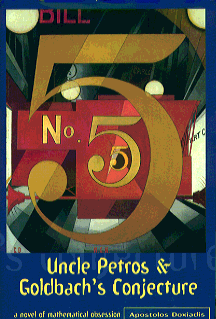Plot
Petros Papachristos, a child prodigy, is brought by his father, a Greek businessman, to the University of Munich to verify his genius with Constantin Caratheodory, a Greek-German mathematician. The boy immediately shows an excellent aptitude for mathematics and graduates soon at the University of Berlin. Later he worked as a postdoctoral researcher at the University of Cambridge, where he collaborates with the mathematicians Godfrey Harold Hardy, John Edensor Littlewood and Srinivasa Ramanujan. He is then offered a professorship in Munich, which he accepts because it was far from the great mathematical centres of the time, and it was therefore the ideal place to live in isolation while tackling the Goldbach conjecture.
After years of fruitless work, Petros arrives at an important intermediate result, which he prefers not to disclose in order not to reveal the object of his research and involuntary help someone else working on the same problem. Later he comes to an even more important result and decides finally to publish it. He sends it to Hardy, whose answer, however, is disappointing: the same discovery had already been published by a young Austrian mathematician. Petros then falls into the deepest depression, taunted by mental exhaustion and the fear that his genius might vanish. Mathematics also begins to enter his dreams, which often turn into nightmares. During a research visit at Trinity College, however, he learns from a young mathematician named Alan Turing of the existence of the incompleteness' theorem by Kurt Gödel.
Returning to Munich, he resumes his work with superficiality, demoralised by the possibility of the unprovability of the conjecture, finding comfort in the game of chess. After a dream he convinces himself that the conjecture is actually unprovable. Before World War II, for political reasons he is repatriated in Greece and he settles in Ekali, a small town near Athens, where he abandons mathematics and devotes himself to chess.
After years of inactivity he establishes a relationship with his nephew, the narrator, who would like to become a mathematician. He attends university in the United States of America and meets Sammy, with whom he discusses Petros' strange mathematical life. Sammy believes that, as the fox in Aesop's fable The Fox and the Grapes, Petros failed to prove the conjecture and then blamed its unprovability. The nephew switches his studies to economics and then returns home to devote himself to the family business, but visits often his uncle, sharing with him the passion for chess. One day, however, he tries to extrapolate the truth from his uncle and awakens in him again the spirit of the mathematician. In the middle of the night the nephew is awakened by the call from his elderly uncle who claims to have solved the conjecture.
This page is based on this
Wikipedia article Text is available under the
CC BY-SA 4.0 license; additional terms may apply.
Images, videos and audio are available under their respective licenses.
